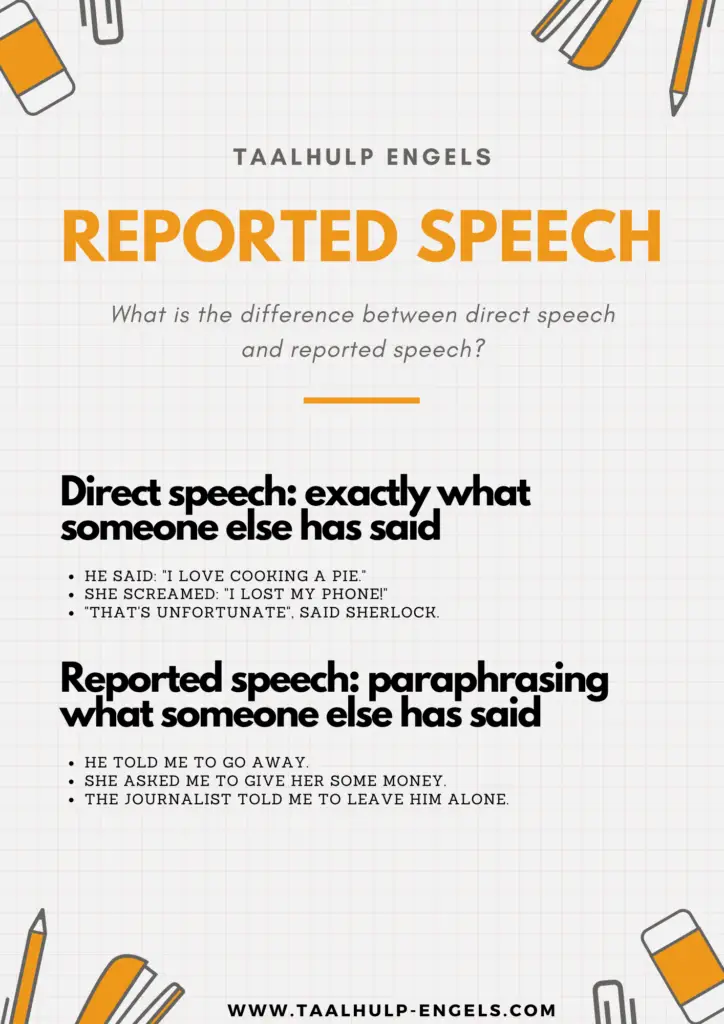Reported speech or indirect speech in English can be difficult if you don’t really know what it is about. That is why this article offers a complete overview of what is meant by reported speech and how to form it with examples. There also are guidelines on how to transform sentences from direct to reported (or indirect) speech.
Difference between direct speech and reported speech in English
In order to know how to form sentences in reported speech, it’s important to know the difference between the two. It all comes down to how you want to say something. You are using direct speech if you are saying exactly what and how someone else said it. If you are retelling something by using your own words, you are using reported (or indirect) speech.

Direct speech in English
Direct speech is something that everyone uses on a daily basis without thinking about it. It’s when you are saying exactly what someone else has said and you’re also using the exact same words.
Keep in mind that direct speech always needs quotation marks (“”) to indicate which part of the sentence is direct speech and to show the exact words someone used. The examples below are all examples of direct speech.
| He said: “I love cooking pie.” |
| She screamed: “I lost my phone!” |
| “That’s unfortunate”, said Sherlock. |
| “When will you be home?” he asked. |

Reported speech in English
Reported speech (or indirect speech) in English is different because you don’t just repeat what someone has said. Instead of repeating it, you paraphrase it using your own words. The main idea is the same, but you use your own words to give information.
Reported speech is mostly used to talk about events in the past. Keep in mind that reported speech doesn’t need quotation marks. The examples below are examples of reported (or indirect speech) in English.
| He told me to go away. |
| She asked me to give her some money. |
| The journalist told me to leave him alone. |
| You said you don’t like the food here. |
As you can see in the examples above, verbs like ‘to tell’, ‘to ask’, and ‘to say’ are used in a lot of sentences in reported speech. These are ‘reporting verbs’ and indicate that reported speech is used to paraphrase what has already been said.
How to form direct speech in English
It’s pretty easy to form sentences using direct speech. You put the information between quotation marks so it’s clear for the reader/listener. Usually, you first put the name of the speaker, followed by ‘:’, and finally the message between quotation marks.
The information between quotation marks is seen as a separate sentence (if the subject is at the beginning) so you need to use a capital letter. Take a look at the following examples:
| Donald Trump said: “I am the best president ever.” |
| My lawyer said: “You are not going to win this case.” |
How to form reported speech in English
Reported or indirect speech is used to talk about something someone has said. However, you’re not using the exact same words. There are different ways of expressing reported speech in English, but it depends on which kind of sentence you have.
You need a reporting verb (to say, to tell, to ask) to indicate that the sentence is reported speech. The tense of the reporting verb is really important for the tenses in the rest of the sentence.
Reported speech in a statement
It’s pretty easy to use reported speech for an ordinary sentence (or a statement). This is done by using ‘that’, followed by the part in reported speech. You don’t always need to use ‘that’ because you can leave it out in some sentences. Take a look at the examples below.
| Direct speech | Reported speech |
|---|---|
| Paul: “You were late.” | Paul tells me that I was late. |
| Paul: “You were late.” | Paul tells me I was late. |
You see that you can use ‘that’, but it’s not necessary.
Reported speech for a yes-no question
You can also use reported speech for yes-no questions in English. This implies you repeat the content of the question without using the exact same words.
In order to do this, you need to use ‘if’ or ‘whether (or not)’. Take a look at the examples below.
| Direct speech | Reported speech |
|---|---|
| The students: “Do you want a beer”? | The students ask me if I want a beer. |
| My teacher: “Do you like dogs”? | My teacher asked me whether I like dogs or not. |
| My friend: “Do you want to join me”? | My friend asks if I want to join him. |
Reported speech for question word questions
It’s also possible to use reported speech for question word questions in English. It’s important to repeat the question words in the new sentence. Take a look at the examples below.
| Direct speech | Reported speech |
|---|---|
| The professor: “Why didn’t you do the exercise?” | The professor asks me why I didn’t do the exercise. |
| My neighbour: “What was that sound?” | My neighbour asks me what that sound was. |
| King Julian: “When do I like to move it?” | King Julian asks when he likes to move it. |
Change direct speech into reported speech
There are a couple of things you need to keep in mind if you want to transform direct speech into reported speech. One of these elements is the tense of the reporting verb.
If this verb is in the present simple, you use the same tense as the original sentence. If the reporting verb is in the past simple, the tenses in the new sentence change. This process is described as ‘backshift’ because each tense shifts back one spot further into the past. Take a look at the examples below.
| Direct speech | Reported speech |
|---|---|
| The boss: “I am very nervous.” | The boss says he is very nervous. |
| The boss: “I am very nervous.” | The boss said he was very nervous. |
In these examples, ‘to say’ is the reporting verb. If this verb is in the present simple, the tense in the sentence doesn’t change. The reporting verb in the second example is in the past simple, so the tense in the reported sentence shifts back one spot. The table below offers a complete overview of what happens to each tense if the reporting verb is in the past simple.
| Direct speech | Reported speech | |
|---|---|---|
| Present simple -> past simple | The boss: “I am very nervous.” | The boss said he was very nervous. |
| Present continuous -> past continuous | The boss: “I am feeling very nervous.” | The boss said he was feeling very nervous. |
| Present perfect -> past perfect | The boss: “I have been very nervous.” | The boss said he had been very nervous. |
| Past perfect -> past perfect | The boss: “I had been very nervous.” | The boss said he had been very nervous. |
| Will -> would | The boss: “I will be very nervous.” | The boss said he would be very nervous. |
| Can -> could | The boss: “I can be very nervous.” | The boss said he could be very nervous. |
If the speaker thinks that what is being said is still true, no backshift is needed and the tenses stay the same, even when the reporting verb is in the past simple.
The subject is also something you need to pay attention to. It’s possible that the subject changes because you’re saying what someone else has said. Take a look at the example below.
| Direct speech | Reported speech |
|---|---|
| My friend: “I am very kind.” | My friend says he is very kind. |
In sentences like this one, you need to change the subject so the meaning is the same in both sentences. In the first sentence, the subject is talking about himself, but you are talking about him in the second sentence. This means that ‘I’ changes into ‘he’.


Exercises
Related articles


